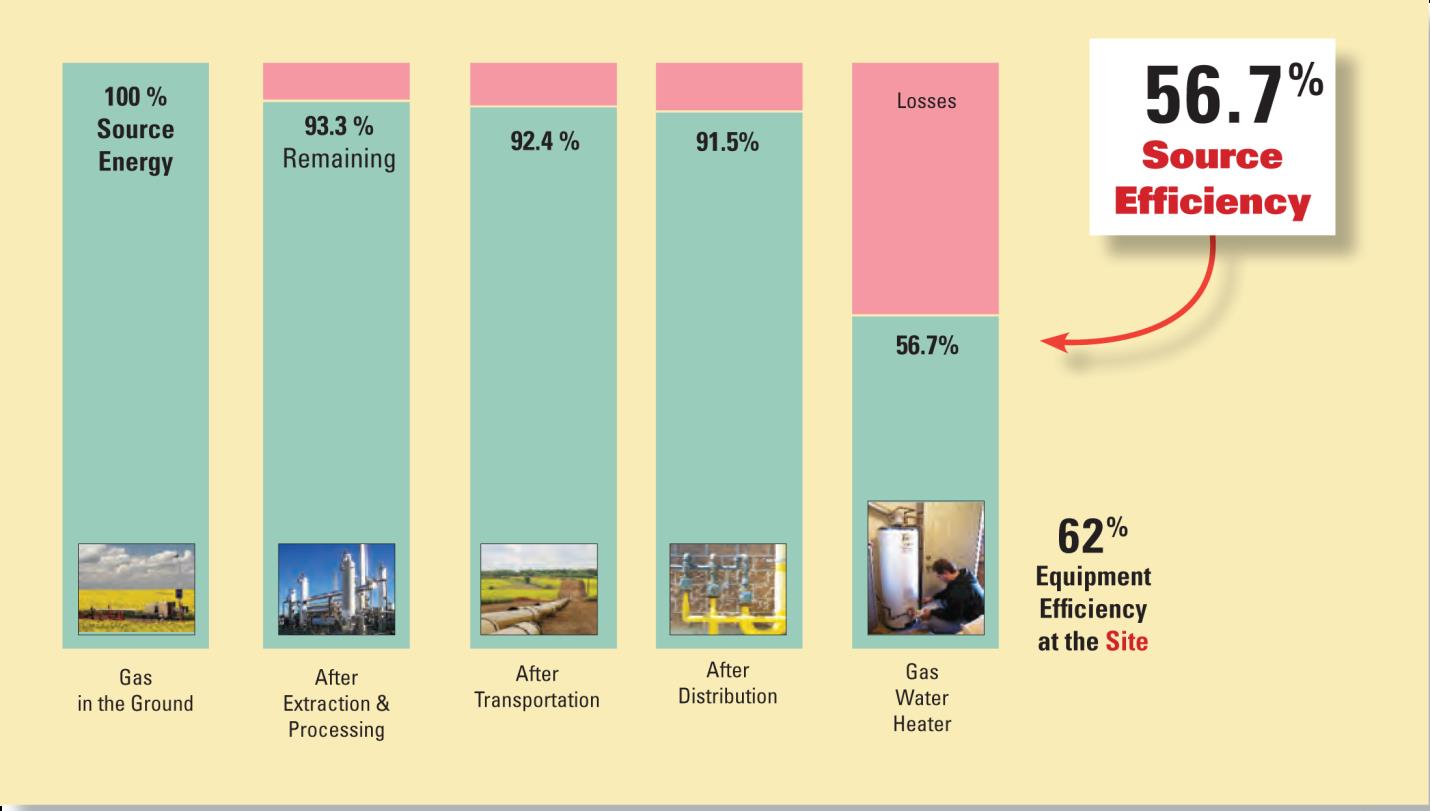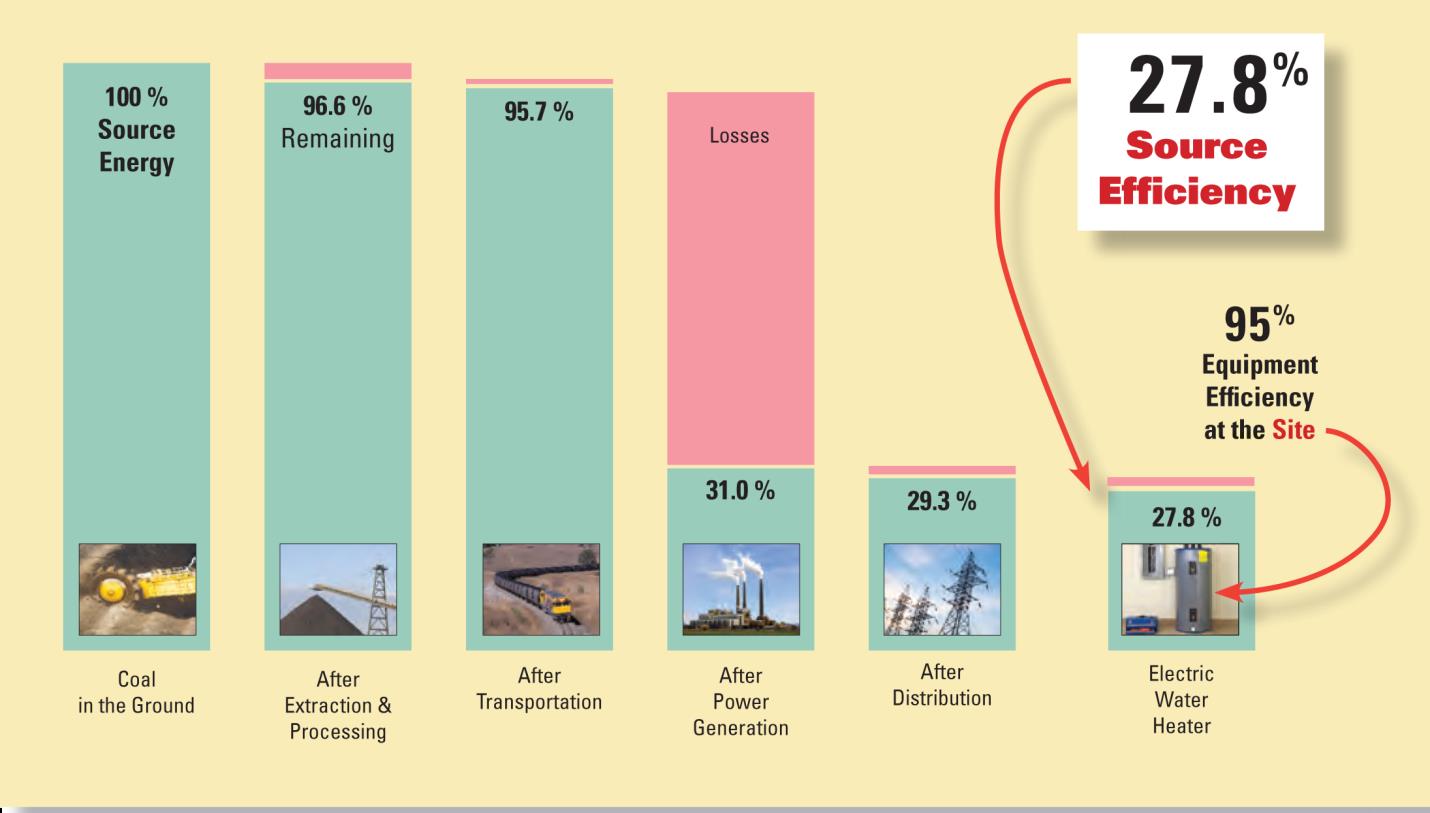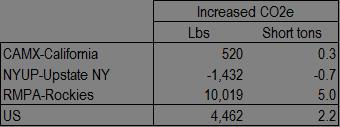“Grid-Enabled” Water Heating: “Deep Decarbonization” as Crony Environmentalism (Part II)
By Mark Krebs -- March 10, 2016[Editor note: An under-the-radar energy intervention is to force fossil-fuel fired water heating to go electric “regardless of adverse economic impacts,” as Mark Krebs explains in this post and Part I yesterday.]
Why should electricity monopolize energy if gas-fired alternatives are more economical as determined by self-interested consumers?
If the objective is low carbon water heaters, there are more direct means of doing so. The following graphics compare the full fuel-cycle efficiencies of traditional gas water heater to electric water heaters:
Gas Storage Water Heater Site and Source Energy Efficiency
Electric Resistance Storage Water Heater Site and Source Energy Efficiency
Note: The previous two graphs are used with permission form the Gas Technology Institute
The electric utility industry prefers a site-based energy efficiency metric because it can indicates that switching to an electric resistance water heater from a gas water heater can “save” over 30% more energy. This is tantamount to expressing a belief that energy is somehow created inside of utility meters.
Also as shown above, gas water heaters are about twice as efficient as electric resistance water heaters on a full fuel-cycle/source basis. What about heat pump water heaters? Aren’t they supposed to be about twice as efficient as standard electric water heaters? While that may be true on the basis of on-site (metered) performance, gas water heaters can also employ advanced technologies; including heat pump technologies.
For an electric heat pump water heater with a rated energy factor (EF) of 2.2, it is only 4% higher in true efficiency (from a full fuel-cycle perspective) compared to a tank-less gas water heater. And a standard gas storage water heater is only 28% higher than the electric heat pump water heater.[1]
But there are also gas heat pump water heaters under development that have demonstrated EF of 1.3. Therefore, given the same methodology (e-GRID and SEEAT), an electric heat pump water heater would lose a true efficiency contest by a wide margin from a carbon and source energy perspective. When will gas heat pump water heaters become available to the public? It’s hard to predict; maybe a year or two. The developers are being conservative and the low cost of natural gas may actually be slowing deployment.
Again, using EPA’s 2012 version of e-GRID, the following table from an in-house spreadsheet summarizes additional CO2 equivalent from a 97% AFUE electric water heater replacing a 62% AFUE gas water heater.
Note that e-Grid emissions represent averages. Marginal generation and emissions thereof is not in the public domain; as far as I know. The California “duck curve” mentioned in the “Hidden Battery” study is just that: California’s. And it only limitedly depicts marginal generation for California. Things can and are very different elsewhere. To get an idea how different emissions are on a regional basis please refer to the eGRID 2012 Summary Tables.
In order to insure that only “clean energy” electrons are used to power electric “grid enabled” water heaters (or any other “electro-technology”), two things need to happen:
- All electrons need to be color-coded
- An electron filter needs to be employed so that only the “green” ones are let through.
Until then, if the objective is cleaner and more economical water heaters, there are also more practical/direct means of doing so. Basically, the electric utility industry is playing both sides of global warming fence. The agenda of How to Power the World without Fossil Fuels is also an highly theoretical agenda in which electricity gains a near monopoly over energy. I contend the electric utility industry’s main motive is classic “rent-seeking” enabled by regulatory “clean energy” machinations. Simply put (but not too simply): “deep decarbonization” equals progressive electrification. The underlying themes of this include:
- The domination of electric generation by renewables requires the electric grid.
- If the electric industry plays along with the politically correct but practically impossible economics of the” all renewables all the time” cult, their market share would at least double through the controlled conversion to electricity of appliances directly served by natural gas and propane.
- Their claim that this is best for the World environment and World economy largely rests upon “levelized costs of electricity” (LCOE) studies that, in addition to being less polluting than fossil-fueled alternatives, are rapidly becoming less costly as well.
- At some point, once viable alternatives to electricity have been decimated, the electric utility industry and their “environmental” allies will effectively say: “Oops; I guess we were wrong. Renewables can’t handle it all, at least without severe restrictions upon living standards.”
I’m not the only one that has recently noticed and written about the growth of the environmental/electric utility complex. For example, the following article just came out in the Wall Street Journal: How Utilities Team Up With Greens Against Consumers.[2] The following are excerpts:
- In other words, unlike companies doing business in a competitive market, for whom unnecessary spending is a deadweight on earnings, utilities actually profit from building a more costly system, so long as it is politically popular.
- So it goes: Environmentalists put their feel-good sentimentalism into action by leaning on their lawmakers; the state uses its power to make regulated electric companies into a vessel of green activism; and utilities agree in exchange for being able to drive shareholder returns with risk-free investments on the backs of captive customers.
It is also worth noting that the author of the above article, Travis Kavulla, is the president of the National Association of Regulatory Utility Commissioners (NARUC) and the vice chairman of the Montana Public Service Commission.
Albeit older and definitely more eclectic, the following articles also attest to these trends:
- San Francisco Bay Guardian (Oct 1997): THE PRIVATE ENERGY ELITE[3]
- EPRI Journal (Nov/Dec 1996): Technology and the Transformation of the Electricity Industry[4]
- Multinational Monitor (Sep 1994): The Demanding Side of Utility Conservation[5]
The following provides a prime example of highly biased LCOE studies: 2016 SUSTAINABLE ENERGY IN AMERICA Factbook (from page 35). This is a joint project of the Business Council for Sustainable Energy and Bloomberg New Energy Finance). There have been a few rebuttals from bona-fide economists that have challenged the reoccurring theme that renewable electricity is at least getting close to the point of being cheaper than fossil-fueled electricity. However, no LCOE study has ever considered the obvious truth that there are alternatives to electricity. Never; not even once. Even more puzzling is the fact that some natural gas (and propane) trade associations belong to the Business Council for Sustainable Energy.
Perhaps these trade associations feel it is best to capitulate to environmentalists and their electric utility allies that powering the world without fossil fuels is inevitable. However, any potential short-term reprieve likely comes at a much higher long-term cost; that being an electrical energy monoculture.
If this sort of crony environmentalism continues to take hold, electric vehicle batteries will probably be next; along with off-peak ice storage. In fact, this article indicates just that: ‘A battery in every basement’: How the lowly water heater could power the smart grid. The following is an excerpt:
Ice storage is also “very promising,” said Robin Roy, director of building energy efficiency and clean energy strategy at the NRDC. “The more we look, the more we’ll find there are opportunities.”
These advocates have come up with the wholesome-sounding marketing term “community storage” for these technologies and they apparently plan to expand this into a “National Community Storage Initiative.” Here is what they claim in a similar article titled: Underutilized energy storage resource (its untapped potential is huge):[6]
The emission reductions of community storage will only become compounded as more consumers participate and the electricity sector transitions to cleaner fuels and generation technologies.
In December of 1996, Public Utilities Fortnightly published an article of mine titled, “It’s a War Out There: A Gas Man Questions Electric Efficiency.” In it, I critiqued off peak “thermal energy storage” (TES). After that article, the Edison Electric Institute had a rebuttal published that challenged me on many points; including off-peak storage. Then I presented a surrebuttal of sorts; of which the following is an excerpt:[7]
Basically, TES systems often “crash.” Consequently, if stand-by chillers come on line to maintain air-conditioning requirements, subsequent ratchet clauses may be invoked. On account of these tendencies, some electric utilities have dismantled (or have at least overhauled) their TES programs. For example, in a recent San Diego Gas & Electric’s general rate case, the DSM uncommitted forecast recommended for SDG&E by the CEC in the ER-90 process only includes TES installations for new construction in the high-rise office sector. “TES was deemed non-cost-effective in the other markets.” When tested again by SDG&E in August 1991, “TES was found to not be cost-effective in any sector.”
What I apparently didn’t get into far enough at the time is that thermal energy storage (and especially ice storage) uses more energy than conventional systems. Any decent air conditioning engineer should know and be able to explain why. Perhaps NRDC should consult some of these.
While ice storage might be something new in terms of NRDC’s collaboration with the electric utility industry, NRDC has been collaborating with EPRI to promote electric vehicles for at least 10 years as evidenced by this joint study: “Environmental and Societal Benefits of Electrifying Transportation.” At this rate, electric resistance toaster ovens may not be far behind. After all, bread can be toasted on a “grid enabled” basis “off-peak” and stored for later consumption.
Summary & Conclusions
In summary:
- This article explores some new examples of crony environmentalism.
- If the game is to reduce emissions associated with conventional water heaters, there are better ways to do it and full fuel-cycle analyses are the key.
- If the game is to reduce operating expenses associated with conventional water heaters on a societal basis, there are also better ways of doing it.
- Advanced natural gas end-use technologies could help legitimate environmental sustainability and least-cost energy planning objectives if it weren’t for the well-connected opposition who deem such technologies unworthy.
- This opposition includes several leading environmental activists; including NRDC and others.
- If LCOE analyses are to be objective, comprehensive and transparent, then the “E” should include non-electric alternatives to electric energy.
Joe Romm, currently of Climate Progress, once advised me (when he worked for DOE) that “I” (meaning the natural gas utility industry) “could have it all if I play my cards right.” What he really meant was that my industry should fully support DOE and its fuel cell program. But I don’t want it all. I want energy diversity and a strong economy while minimizing unnecessary environmental degradation. After all, as they say: “it’s for the children.” And I want my children to be able to get a good job, then move out of the house and stay healthy.
————-
Mark Krebs, an engineer by training, has been involved with energy efficiency design and program evaluation for more than thirty years. He has served as an expert witness in dozens of energy-efficiency filings, which he summarized in a Public Utilities Fortnightly article, “It’s a War Out There: A Gas Man Questions Electric Efficiency” (December 1996).
————————————–
[1] Assumes 100% efficiency for renewable power versus EPA’s e-GRID 2012 data calculated through using SEEAT
[2] http://www.wsj.com/articles/how-utilities-team-up-with-greens-against-consumers-1456530275?mod=djemMER
[3] https://savannahblackwell.wordpress.com/2010/04/17/the-private-energy-elite-october-8-1997/
[4] http://elr.info/bibliography/energy/technology-and-transformation-electricity-industry
[5] http://www.multinationalmonitor.org/hyper/issues/1994/09/mm0994_09.html
[6] http://www.smartgridnews.com/story/underutilized-energy-storage-resource-its-untapped-potential-huge/2016-02-11
[7] http://www.fortnightly.com/fortnightly/1997/03/mailbag?page=0%2C3


